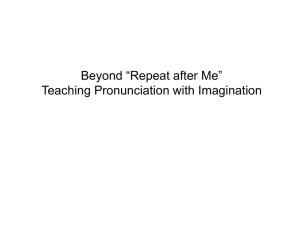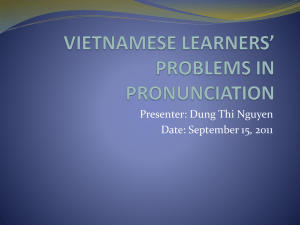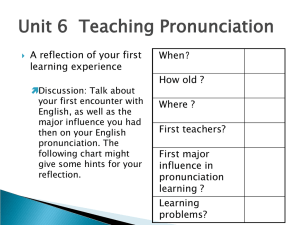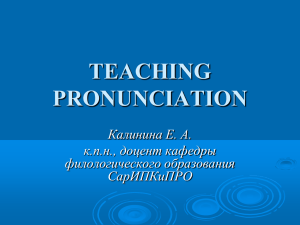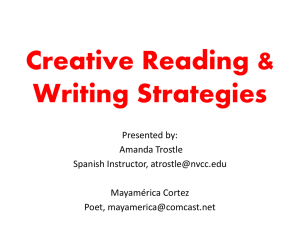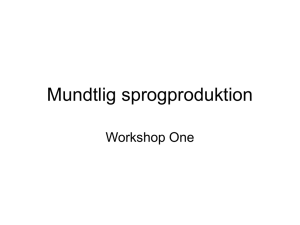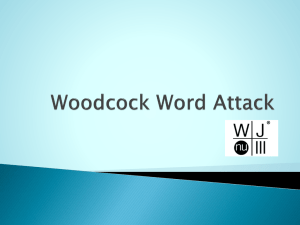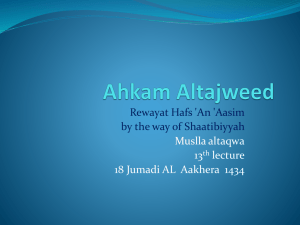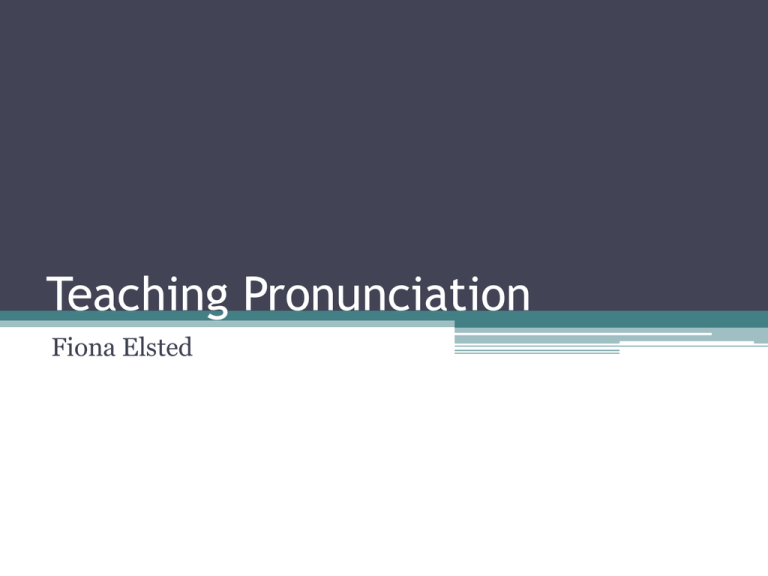
Teaching Pronunciation
Fiona Elsted
What do we teach when we teach
pronunciation?
Features of Pronunciation
Sounds (Phonemes)
• =Consonants (Voiced and Unvoiced) Vowels
(Single (short and long) and Diphthongs)
Suprasegmental Features
• Intonation
• Stress=Word stress, Sentence Stress
• And resultant Rhythm and Sounds in Connected
Speech (assimilation, elision, linking and
intrusion, juncture)
•
•
•
•
Assimilation
He’s a very good boy.
I’ve been going out too much lately.
I went to Liverpool last year.
• Elision
• We went to Preston the next day
• Linking and intrusion
• I agree
• I saw it last night
• Juncture
• I scream, you scream we all scream for ice-cream
• Can I have more ice?/Can I have more rice?
Examples Adapted from Kelly, G., (2000) How to Teach Pronunciation PearsonLongman
English-a stress-timed language
• What has happened to Lulu, mother?
What has happened to Lu?
There's nothing in her bed but an old rag-doll
And by its side a shoe.
Why is her window wide, mother,
The curtain flapping free,
And only a circle on the dusty shelf
Where her money-box used to be?
Why do you turn your head, mother,
And why do tear drops fall?
And why do you crumple that note on the fire
And say it is nothing at all?
“What has happened to Lulu” by Charles Causley
What’s happening here?
• Stressed-timed (isochronous) languages
‘stresses occur at regular intervals within
connected speech ...and the duration of an
utterance is more dependent upon the number
of stresses than the number of syllables. To
achieve the regular stress intervals, unstressed
syllables are made shorter, and the vowels often
lose their ‘pure’ quality..’
• Kelly, G., (2000) How to Teach Pronunciation
Pearson Longman
Questionnaire
• Adapted from:
Thornbury, S., 2001 About Language CUP
Adult learners of English are unlikely to achieve
native-like proficiency with regard to
pronunciation.
• Why might it be difficult for adult learners to
achieve ‘native-like proficiency’ in
pronunciation?
• What is ‘native-like proficiency’ in relation to
pronunciation?
• http://sounds.bl.uk/Accents-and-dialects/BBCVoices/021M-C1190X0043XX-0901V0
• http://sounds.bl.uk/Accents-and-dialects/BBCVoices/021M-C1190X0016XX-0201V0
• http://www.youtube.com/watch?v=OHfIAoF8g
Ec
Intelligibility should be the main aim
of pronunciation teaching
‘Comfortable intelligibility’
Who judges this?
What about those who strive for perfection?
Stress, rhythm and intonation are
more important than getting the
individual sounds right.
‘Without a threshold level mastery of the English
prosodic system, no amount of drilling individual
sounds will increase intelligibility. As one teacher
trainee put it after the training course, ‘Practicing
pronunciation without prosody is like teaching
ballroom dancing-- only the students must stand
still, practice without a partner, and do it all
without music’.’Gilbert, J., 2010 Pronunciation as
Orphan: What can be done? As We Speak,
newsletter of TESOL SPLIS, 2010
http://www.cambridge.org/other_files/downloads/es
l/booklets/Gilbert-Teaching-Pronunciation.pdf
Pronunciation should be integrated into other activities
rather than taught as a separate system.
Pronunciation teaching should start with listening
• Looking at materials in pairs:
• Material 1-The exercises are not in their original
order. Work together to reconstruct the order.
• What is the aim of each exercise. What do you
think about this sequence?
• Have you taught pronunciation in a similar way?
The model here:
• Recognition
• Discrimination
• Production
• Is this the only way though?
• Advantages of Production first, then listening,
then speaking again (Like Task-Teach-Task.)
More materials
• How do published materials do it?
• In pairs look at the examples of published
materials provided.
• -What approach to pronunciation teaching is
taken?
• -Is it effective?
• -Would it work with your students?
Dealing with pronunciation errors on
the spot
o Facial expression: frowning, grimacing etc.
o Asking for repetition: "Again, please“
o Echoing: (with a questioning intonation)
o Denial: "Wrong answer“
o Questioning: "Is that correct?“
o Visual aid: snake picture for third person “-s”
o Checking that others have understood: ‘Did you
understand that?’ ‘What did she say?’
•
Desmond Thomas 2011
How to correct
1. Self-correction by student
2. Peer correction (open invitation to class)
3. Peer correction (specified individuals/in pairs)
4. Teacher corrects student (immediate)
5. Teacher corrects student (delayed)
6. Teacher supplies prompts to help student
7. Teacher and class correct a series of errors
8. Open discussion (round-up) at end of class.
Students should be taught to read
phonemic symbols and use the
phonemic chart
I enjoy teaching pronunciation and
have some techniques for supporting it
in the classroom
•
•
•
•
•
•
•
•
•
Mirrors
Kazoos
DA-da-da
Lip-synch
Drawing on the right side of the brain: backward
chain drilling
Exaggeration
Physicality
Jazz chants
Poetry
What is difficult about teaching
pronunciation?
• Tends to be reactive rather than planned
because teachers are unsure how to deal with it
• Good materials are lacking-pronunciation seen
as the ‘poor relation’
• Phonology has often been taught as a ‘science’
with lots of theory and this can be scary for
teachers (and students)
• The specific terminology associated with
pronunciation alienates some teachers
• What do you think?


